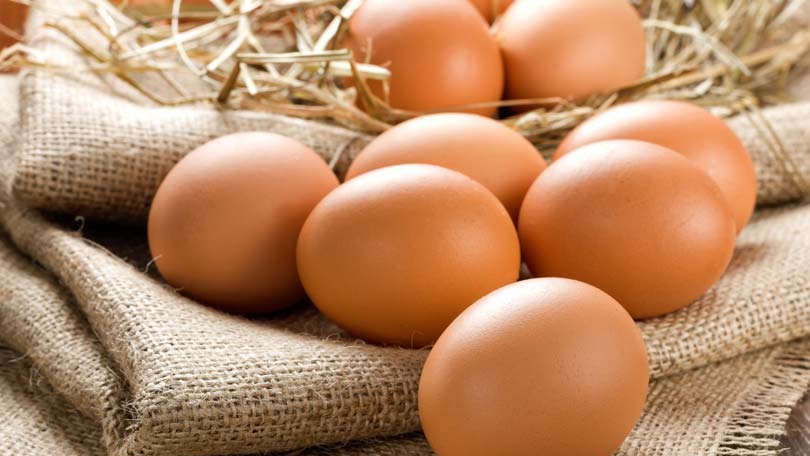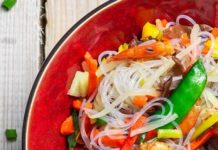
Poached eggs are a wonderful repast, and my favorite way to eat eggs. Low in saturated fats, plenty of protein, essential fatty acids, lots of vitamins and minerals, many of which are difficult to get from other foods, very inexpensive, and best of all, low in calories. Poached eggs have a superb, clean taste to them, that allows the true flavor to shine, while still being very mild and delicate.
So why don’t more people eat poached eggs, and why do restaurant cooks make faces when you order poached eggs? Are they that difficult to prepare correctly? Not at all, but there are a few tricks to it, which will be the ultimate subject of this article. By the time you finish, you should be able to poach like a pro, with no fuss at all.
A Little Egg History…
If you want to really be good at poaching eggs, or cooking them in any manner, you need to understand eggs. We’ve been eating eggs since before we were completely human, as far back as 3 million years! As Hunter-Gatherers, eggs were a logical food choice because they taste great, are easy and quick to cook, and most importantly, they didn’t fight back or run away. This was somewhat important at a time when most animals were 4 or 5 times bigger than us, and at least 50% faster on foot, coupled with the fact that most of them also had large fangs, tusks, big spurs, huge hoofs, and really nasty dispositions. At first, we probably did a whole lot more gathering, than hunting, at least until we learned how to make spears.
We started robbing nests, and figured out which birds had the best tasting eggs, and were the least threatening (they had some really big birds back then…). We eventually decided on chickens. Then, someone got the great idea to just bring the whole chicken home to lay eggs, rather than go looking for them, and thus, livestock production was born. By around 7000 BC, they had egg production down pretty good, at least in China and India, which may be why today, they are some of the biggest consumers of eggs in the world. Egg production didn’t spread to Africa, West Asia, Egypt or the European Continent until around 800 BC. There is evidence that Native Americans domesticated chickens for eggs as far back as 1500 BC.
Eggs were consumed raw at first, but when we invented fire, eggs were roasted in the coals, After we figured out how to make pottery, boiled eggs became very popular, so much that in ancient Rome, there was a saying; “ab ova ad mala”, meaning, “From eggs to apples”. Eggs were a common appetizer and apples were a common desert, so this really meant something to the effect of From Start to Finish, or From the Beginning to the End. It wasn’t too long before people began pickling eggs to preserve them for long trips, frying them, baking them, and of course, poaching them.
Eggology 101
Eggs are a wonder of nature. They are, in effect, a self contained ecosystem for an embryo. The shell breaths and lets in moisture while keeping the contents in. Even its shape is practical. Ever wonder why an egg is oval? It is because if an egg gets loose, or bumped, it will roll in a circle, instead of out of the nest. Neat, huh? The yolk supplies food for the embryo, and the albumen, which is a complete, high-quality protein, cushions it and keeps it moist. Another part of the egg, the chalaza, which is a long white stringy thing on each end of the egg, keeps the yolk from banging against the shell and breaking if it gets bumped. If you ever get an egg with a small dark spot in the yolk, it is not a developing embryo. It is simply a blastoma, or a small piece of extra tissue that serves no purpose. You can eat it safely and it should not effect the taste, but if it bothers you, it can be removed with a fork before, or after cooking. And lastly, sometimes you may find a small air pocket in the albumen. It is perfectly normal and does not effect the egg at all.
Most of the egg, except the shell, is high-grade protein, with some vitamins and essential fatty acids. An average egg only has 76 calories, a meager 1.4 grams of saturated fat, only 5.1 grams of other fats, and a whopping 7.5 grams of the highest quality protein there is.
What about cholesterol? Well, at one time they used to think that eating eggs contributed to high blood cholesterol, but recent studies have shown that there is little or no correlation between consuming edible cholesterol, and cholesterol in the blood. Saturated fats are now believed to be the culprit and the American Heart Association recommends that you eat no more than 16 grams of saturated fats per day. Good news… an egg only has 1.4 grams of saturated fat, and it is unlikely you would eat 10 or more eggs in a day. And the really great thing about poached eggs is that you do not cook them in any fat, so there is no extra saturated fat to worry about. You can instead worry about the bacon, ham, fried potatoes, etc… that usually accompany egg meals. Poached eggs do not require any of these side items. They really go better with things like roasted cherry tomatoes, or any kind of tomato, for that matter, mild sauces, curries, rice and other grains…they really can stand on their own. One of my favorite poached egg dishes is Shashuka, which is just eggs poached in spicy tomatoes with onions and peppers…. Scrumptious.
Getting Down To Business of Poaching an Egg
Now you know enough about eggs to be able to successfully poach them. There are just a few things you should keep in mind before you start.
- You want to use the best eggs you can get. Chickens that are fed hormones, also known as laying feed, will have watery, pale yellow yolks and a thin albumen (which will be the egg white). Most store-bought eggs will be of this type. Organic eggs usually have a darker, yellow-orange color to the yolk and a thicker albumen. Cage-Free eggs will have a darker orange-yellow color, a nice thick albumen, and tons of flavor. The absolute best egg is one direct from a free-range, organic chicken, that has never been refrigerated.
- Farm eggs will look dirty, but they have a film on them that protects them from spoiling for around a month at room temperatures, so avoid washing them until you get ready to use them. All the dirt and whatever is on the outside shell only. You can keep them at room temperature until ready for use, and you won’t have to let them warm up before-hand. Store bought eggs are always washed, so they have to be refrigerated. If you are unsure of the freshness of your eggs, here is an old trick. Fill a deep bowl with cold water and place the eggs in it. Fresh eggs will sink to the bottom. Old eggs will float. Discard the old eggs, dry the good ones and put them up. Be advised that once you do this, your eggs will have to be washed and refrigerated, or used immediately.
- Eggs are mostly protein, which can be fragile on a molecular level. It’s why the body can use it so easily. Treat the eggs gently and do not agitate them more than is necessary. Breaking the amino chains can result in rubbery, strong flavored eggs. This is one of the most common mistakes cooks make when trying to cook eggs. It will also result in less loft, and less leavening, so if you break the amino chains, you can say goodbye to light, fluffy scrambled eggs.
- In almost all cases, eggs respond better to cooking when they are at room temperature. You can use them cold, but you will not get the best from your eggs that way. This is especially true when poaching.
- Never crack eggs directly into the water. Always crack them into a small bowl first, so you can inspect them before cooking. Also, it saves you from having to discard the water and start over should a yolk break coming out of the shell (and it does happen to everyone sometimes, mostly with store-bought eggs…). Once you are satisfied with the eggs, gently ease them into the hot water.
- You will have less chance of breaking the yolk if you crack the egg on a flat surface, rather than an angled one, like the edge of a counter, stove, or a butter knife. Angled pressure can force the shell into the egg, possibly breaking the yolk. It also can result in the shell flaking and falling into the egg, forcing you to dig the little pieces out, and maybe breaking the yolk in the process. There are some great YouTube videos on how to properly crack an egg. Watch them and practice a lot. Eggs are cheap and can be used in hundreds of different ways, so there really is no excuse not to practice.
- Never, never, never add any junk to the water to make the egg coagulate. Vinegar and citric acids will destroy the amino chains, and result in a rubbery, tasteless egg that may taste of vinegar….yuck!!!!!
- Some people swear by swirling the water before slipping the egg in, and others say not to disturb the water any more than necessary, or it will damage the aminos. Swirling causes the egg to fold in upon itself as it solidifies, making a tight-looking egg. Not swirling allows the egg to create strings and shapes as it does its thing, but these will tuck back in when the egg is removed from the water. I feel the egg has better flavor and texture if you don’t agitate any more than you have to, but it is your choice. It is a very subtle difference.
- A common mistake is to add eggs to simmering water. That is not poaching. It is simmering, and doesn’t taste anything like a properly poached egg. Remember, we want to avoid shaking the egg up as much as possible, and simmering/boiling water will cause the egg to bounce around and rattle the yolk. The proper temperature for poaching and egg is 180ᵒF to 190ºF. Water boils at 212ᵒF. What you want to do is to heat the water in your pot until you just start to see tiny, tiny bubbles start to form on the bottom. Then lower the heat a little, and slip in your eggs. The water will cool a little more when you add the eggs, especially if you use cold eggs.
Now, we are ready to cook. Get all of your items together before you start. You will need:
- A pan at least 2” deep. Deeper is better.
- A slotted spoon for removing the eggs once they are done.
- Plates, ready to go.
- Any extra things you want, like tomatoes, side-dishes, etc… Make sure they are prepared before you start the eggs, because eggs poach very quickly, and demand your full attention.
- A small bowl to crack the eggs in.
- Salt and pepper to taste.
- Any extras like hot sauce, Hollandaise, condiments, etc…
Get your eggs out of the fridge (unless they are already room temperature…), and allow them to warm. This can take up to 30 minutes.
Once the eggs are properly warmed, fill your pan 3/4 of the way with water. Set the pan on the stove and set the burner to High Heat.
Watch the water closely, and when you see small bubbles begin to form on the bottom of the pan, lower the heat to Medium High.
Crack your eggs gently into the bowl and inspect them. Once you are satisfied, slip them gently into the water. Do not swirl the water. Do not add vinegar or citrus.
The eggs will curl, and act like lovesick amoebas for a few seconds. Don’t worry. It’s normal. As a rule, 3 minutes will give you a creamy, delicate white with a slightly thickened, but still runny yolk. 4 minutes will give a firmer white, and an almost solid yolk. 5 minutes will give you a very firm, but still edible (so they say…) white, and a solid yolk. Any longer and all you will have is a coaster for your coffee cup…. I cook mine 2 minutes…. These times are for a single egg. For every extra egg, add 30 seconds to the times.
When the eggs are to your liking, turn off the burner and gently remove them from the water with a slotted spoon. Allow them to drain over the pot for a bit, or you can set them on a paper towel to dry the excess water. No one likes a bunch of messy used egg water on their plate…
Transfer the eggs to the plates, garnish and chow down….
Shashuka
 This is so easy that I don’t think it even qualifies as a recipe. You only need 5 components:
This is so easy that I don’t think it even qualifies as a recipe. You only need 5 components:
Eggs
Tomatoes. You can use fresh, or canned. You can even use tomato sauce, for a different texture. The flavored canned diced tomatoes work really good in this, like the ones with peppers and onions already in it, chili-ready, Italian, etc… My favorite is Snappy Tom with Green Chilies.
Something for heat (if desired) like peppers, hot sauce, dried chilies, etc… I use Carolina Reaper Pepper Sauce, but it is not for the faint-hearted. You can leave this out if you don’t like hot stuff.
Something for spice, like onions, curry powder, garlic, cilantro, green peppers, etc…
A little top garnish for some flair, like parsley, cilantro, fresh basil, etc…
You can even add some meat, like bacon pieces, ham, sausage, canned sardines or mackerel, ground beef, etc…. I personally think it takes away from the eggs, but it’s your food. Make it like you want. Other than burning it, I really don’t think you can mess this up.
Procedure:
Start by placing a large skillet on the stove over Medium High heat. Depending on how done you want your eggs, you may want to have a lid handy. Allow the skillet to heat up a bit before proceeding, maybe 3 or 4 minutes. If a drop of water sizzles, it’s ready.
Add a tablespoon of oil to the skillet. I highly recommend good olive oil.
Add your chopped onions, chopped garlic, chopped peppers, or any other raw veggies, and sauté them until the onions are translucent, and celery (if any) is tender. Fresh jalapeño peppers are great to add at this stage…
Add the tomatoes, juice and all, stir, and allow them to simmer for a bit. You can add any hot sauces now, if you want. When everything is simmering nicely, proceed to the next stage.
Add any extra spices you want now, like salt and pepper, red pepper, garlic powder, curry powder, etc… Add them to your taste. Stir well and continue to simmer.
This is one of the few times I will say it is OK to crack eggs directly into your skillet. There is no other way to do this. With a spoon, make a well in the tomatoes for each egg. Now, crack each egg carefully into its well. If a yolk breaks, don’t worry. Just crack another egg on top of it. It will be fine…
It is very important at this stage that you do not stir, shake or disturb the eggs in any way, until they are done.
If you want well-done eggs with a solid yolk, place a lid on the skillet. Check the eggs often.
When the eggs are done to your liking, use a ladle, or large spoon to lift each egg and tomato well onto your plates. Extra tomato sauce that is left can be arranged around the eggs.
Garnish, add the extras, and chow down. Shashuka is traditionally served with an Indian Flatbread called roti, but I will tell you a secret…. Roti is pretty much just a flour tortilla, and regular flour tortillas can be substituted for it anytime. You won’t know the difference.
I hope you have enjoyed this article. Check back with us often for more great material.
Bon apetit.





